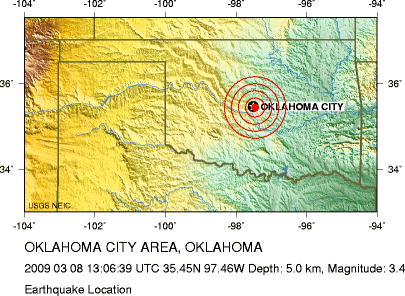
© US Geological Survey
Sunday, March 08, 2009 at 13:06:39 UTC
Sunday, March 08, 2009 at 08:06:39 AM at epicenter
Location 35.447°N, 97.457°W
Depth 5 km (3.1 miles) set by location program
Distances:
* 1 km (0 miles) S (174°) from Smith Village, OK
* 1 km (1 miles) WNW (287°) from Del City, OK
* 5 km (3 miles) NNE (26°) from Valley Brook, OK
* 8 km (5 miles) ESE (119°) from Oklahoma City, OK
* 301 km (187 miles) NNW (348°) from Dallas, TX